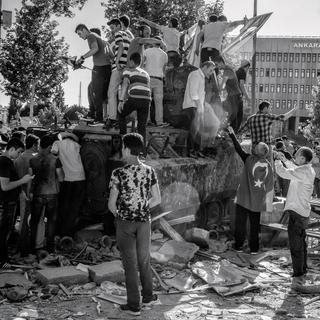


Photographer Emin Özmen captures Turkey's turmoil
In picturesFor more than 15 years, this Turkish photojournalist has crisscrossed his country, capturing its key events: the war against the Kurdistan Workers' Party, the conflagration in Syria, the protest movements and more. His recent book, 'Olay,' presents images of a people caught up in history.
It has been said that Turkey is not an easy country. It's something that photographer Emin Özmen knows all about. He was not yet 10 years old when he and his stunned parents experienced the horror of Madimak, the hotel in his hometown of Sivas, a rugged Anatolian city, that was set on fire by radical Islamists after Friday prayers on July 2, 1993. The angry crowd had cut off the firemen's hoses to prevent them from putting out the flames, resulting in the deaths of 37 people who were trapped in the building. Most of them were intellectuals and artists who were members of or close to the Alevi community, a heterodox branch of Islam despised by conservative Sunnis.
"Why? Who were the Alevis? What did they do? This event left so many unanswered questions in my mind that it took me years to try and understand," the photographer says today. It was on that day, he says, that he lost his "innocence." He also decided that going forward, he wanted to "understand, document everything, and figure things out to compensate for the helplessness and disbelief felt in that moment."
Özmen didn't become a historian. Instead, he became a photographer with a sense of urgency, in a hurry to capture those moments when life turns upside down and loses its normal parameters and reference points. For more than 15 years, ever vigilant and with his camera slung over his shoulder, he has captured in disconcerting and breathtaking fashion these moments of rupture imbued with silence and emptiness but also noise and fury. At a time when worlds are colliding and violence has compounded matters, he has reminded us that to photograph something is to remember and relive it.
The rise of Recep Tayyip Erdoğan
Ten years after the Sivas massacre, Özmen abandoned the study of physics and began traveling the roads of Turkey. As he made his way along, he encountered everyday life in Turkey − its rules and prohibitions, its differences and infinite variety. He talked to the people, questioning them on every subject: identity, power, society, religion, nationalism, racism. He photographed "absolutely everything, as if to forget nothing." In 2008, he was recruited by Sabah, one of the country's leading daily newspapers. The young man found himself covering the most significant events of the day.
These years coincided with the rise of Recep Tayyip Erdoğan, the country's president since 2014. They were years of promises for an end to more than two decades of conflict with the armed Kurdish groups of the Kurdistan Workers' Party. For a safer, more prosperous future, particularly in the southeast of the country. And for closer ties with Europe. "Everything inevitably collapsed in the years that followed," says the photographer. In 2011, neighboring Syria went up in flames. The Gezi Park protests two years later in Istanbul sparked an uprising across the country that resulted in violent repression.
You have 30% of this article left to read. The rest is for subscribers only.
